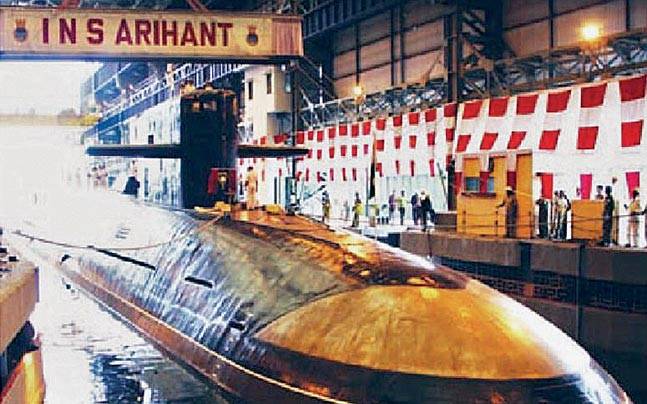Nuclear-powered submarine: India
This is a collection of articles archived for the excellence of their content. Readers will be able to edit existing articles and post new articles directly |
Contents |
INS Arihant
2009
India Today.in , Wolves of the sea “India Today” 15/12/2016
On July 26, 2009, India formally launched its first indigenously designed and constructed ballistic missile submarine (SSBN), the INS Arihant, the culmination of a project that began in the 1960s. The long gestation period could be explained by the fact that SSBNs are among the most complex military platforms ever developed. They call for a simultaneous mastery of technologies spanning the ocean depths and space-underwater nuclear propulsion, sea-launched ballistic missiles and nuclear weapons. This is the reason why only the P5 countries have fielded SSBNs. The INS Arihant's nuclear reactor, developed by the Bhabha Atomic Research Centre, gives it almost indefinite underwater endurance. Its four indigenously 'K-4' nuclear-tipped submarine launched ballistic missiles (SLBMs) have a range of over 3,000 km making it the third and most lethal leg of the triad declared in India's nuclear doctrine of 2003.
2013: Reactor On INS Arihant Goes Critical
India Breaks Monopoly Of Big 5 Which Have Veto Power In UN
The Times of India 2013/08/11
With its miniature reactor going critical, nuclear submarine INS Arihant will now head for open waters for extensive sea-based acceptance trials. The trials, which will include firing of the 750-km range K-15 ballistic missiles, will take at least 18 months
1970 India’s hunt for a nuclear submarine began when Indira Gandhi asked BARC, DRDO and others to build one. There was no progress for many years till the late-1990s, when the actual construction of the first hush-hush advanced technology vessel (ATV) began
2009 The first ATV, named INS Arihant (destroyer of enemies), launched into water on July 26 by flooding the dry dock at the Shipbuilding Centre at Visakhapatnam. Since then, it has undergone extensive harbour trials on shore-based high-pressure steam
2012 India inducted a nuclear-powered submarine, INS Chakra, last year on a 10-year lease from Russia, but it’s not armed with nuclear-tipped missiles due to international non-proliferation treaties like the Missile Technology Control Regime
2013 INS Arihant’s reactor goes critical in the early hours of August 10. It will now head for seaacceptance trials before becoming fully operational
A nuclear-powered submarine with nuclear missiles is considered the most effective and difficult-to-detect deterrence platform. N-powered subs can operate underwater at long ranges for months on end, unlike conventional diesel-electric submarines that need to surface every few days to get oxygen to recharge their batteries & have limited endurance due to fuel requirements
N-Sub To Make Nuclear Weapon Triad A Reality
Rajat Pandit TNN
New Delhi: Arihant, which translates as the “destroyer of enemies” from Sanskrit, nowhas a new “heart” totake the battle to enemy shores. The miniaturized atomic reactor on board India’s first indigenous nuclear submarine, INS Arihant has “gone critical”, in a big leap towards making the country’s longawaited “nuclear weapons triad” an operational reality.
Sources said the 83mw pressurized light-water reactor,fuelledby enricheduranium, achieved “criticality’’ lateon Friday after monthsof “checking and re-checking” of all the machinery, systems and sub-systems of the 6,000-tonne submarine at the heavily-guarded ship-building centre at Visakhapatnam. The green light for the reactor tobe “finally switchedon” was apparently given by the top-secret meeting of the Nuclear Command Authority, chaired by PM and attended by CCS members on July 31.
On Saturday, congratulating the navy, department of atomic energy and DRDO for the milestone, the PM said it marked “a giant stride” towards enhancing the country’s security. Only the Big-5 — the US, Russia, China, the UK and France – currently operate nuclearpowered submarines armed with nuclear-tipped missiles. To be followed by INS Aridhaman and another similar vessel already being constructed under India’s “most secretive strategic project” for which over Rs 30,000-crore have already been sanctioned, INS Arihant was so far being powered and tested in the harbour with high-pressure steam from the shore. The umbilical chord has now been cut. With the submarine now powered by the self-sustained, fission reaction in the reactor fitted inside a containment chamber in the hull, it will eventually head for open waters for extensive “sea-acceptance trials” with a 95-member crew led by Captain Sanjay Mahendru.
“Even if everything goes well, the submarine will still take a minimum of another 18 months to become fullyoperational and go on deterrent patrols,’’ said a source.
Another reality check is that the 110-metre-long and 11-metre broad INS Arihant will initially be armed with the K-15 ballistic missiles that have a strike range of just750-km.They,too,will require testing during the extensive sea trials.
A significant milestone, but not enough
But, despite the significant milestone of nuclear submarine INS Arihant's atomic reactor going "critical" in August 2013, the Navy's depleting fleet of 14 aging conventional diesel-electric submarines remains a big source of worry.
The ongoing over Rs 23,000-crore Scorpene submarine construction project at Mazagon Docks is running four years behind the original 2012-17 induction deadline. Moreover, the government has failed to kick start the long-pending second project for six new-generation stealth submarines with both land-attack missile capabilities and air-independent propulsion for greater endurance at a cost of over Rs 50,000 crore. Though Antony on Monday said the project was now in the Cabinet Committee on Security (CCS) for approval, the first submarine under it can roll out only by 2022 at the earliest.

